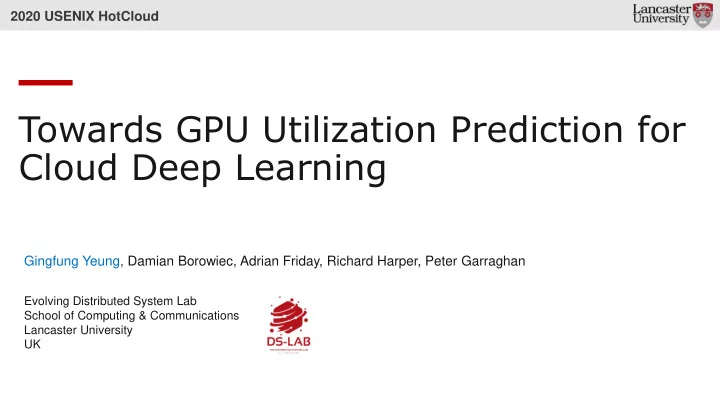

2020 USENIX HotCloud Towards GPU Utilization Prediction for Cloud Deep Learning Gingfung Yeung, Damian Borowiec, Adrian Friday, Richard Harper, Peter Garraghan Evolving Distributed System Lab School of Computing & Communications Lancaster University UK
Deep Learning (DL) Systems Growing number of Machine Learning engineers, More Deep Learning expensive GPUs researchers, users (DL) workloads Require efficient resource usage & high DL performance 2
DL System Challenges • Avg. GPU utilization ~ 52% in production systems [ Jeon et al. ’19 ] DL System Challenges • Long job completion + queue times ~ up to hours [ Jeon et al. ’19; Gu et al. ‘19 ] Addressed via understanding and exploiting workload patterns 3 3
Online profiling approach Deploy workload into isolated machines and GPUs to obtain workload patterns Workload Workload Resource Profile Monitor Response GPU-1 {Utilization = 20, Memory = 4GiB,Bytes…} GPU-1 GPU-2 GPU-2 {Utilization = 40, Memory = 6GiB,Bytes…} Node Usually per workload profiling range from minutes to hours 4
DL Metrics • Iteration time • Useful for scale-out workers, migration, SLA-aware inference • [ Peng et al. ’18; Xiao et al.’ 18; Shen et al.’ 19 ] • Network I/O • Useful for efficient distributed training • [Gu et al. ’19] • GPU Utilization • For packing and calculating interference • [Thinakaran et al. ’19; Xu et al. ’19] 5
Case: Scheduling Scheduling Loop 1. Query Resource Make decision based on Scheduler Monitor workload patterns from profiling 2. Issue 3. Migrate Resource Management Framework 6 6
Time is Money If the system has many heterogenous workloads, will lead to head-of-line blocking. • N workload × mins … … Workload Queue Profiling Stage Scheduling Stage (mins) 7
Online Profiling • Pros • Accurate, near real-time workload patterns • Provide insights to the system • Cons • Heterogenous workloads require different profiles • Time consuming (~mins to ~hours) • Require modifying underlying frameworks 8
Online Profiling • Pros • Accurate, near real-time workload patterns • Provide insights to the system • Cons Obtain prior execution ? • Heterogenous workloads require different profiles • Time consuming (~mins to ~hours) • Require actual execution onto an isolated machine • Require modifying underlying frameworks 9
Prediction • N workload × seconds Reduce blocking … … Workload Queue Prediction Stage Scheduling Stage (sub-second – seconds) 10
DL System Challenges • Avg. GPU utilization ~ 52% in production systems [ Jeon et al. ’19 ] DL System Challenges • Long job completion + queue times ~ up to hours [ Jeon et al. ’19; Gu et al. ‘19 ] Addressed via understanding and exploiting workload patterns 11 11
DL Metrics • Iteration time • Useful for scale-out workers, migration, SLA-aware inference • [ Peng et al. ’18; Xiao et al.’ 18; Shen et al.’ 19 ] • Network I/O • Useful for efficient distributed training • [Gu et al. ’19] • GPU Utilization • For packing and calculating interference • [Thinakaran et al. ’19; Xu et al. ’19] 12
Objective GPU utilization prediction engine for Cloud DL Systems Benefits • Estimates GPU utilization of unseen workloads • Prior to execution • No modification of existing DL frameworks • E.g. PyTorch, TensorFlow, MXNet… Analysis, prediction model, case study 13 13
DL computation graph Going deeper with convolutions [Szegedy et al 2014] Features: Num. Convs, FLOPs, layers, etc. Leverage graph information to (See paper for full features list) predict workload usage. 𝑔 𝑦 → 𝑧 14
Analysis • Profile DL workload utilization • Determine important model features • Set up • Nvidia 1080, Nvidia 2080, Intel i7-6850k • 13 DNN model architectures, 81 workloads See paper for full list of models and permutations. • Tools • Nvidia-smi • Nvidia Nsight Systems 15 15
Analysis 100 CNN GPU Utilization % RNN 80 GFLOPs 60 40 20 0 GPU Utilization % 16 16
Analysis 5x 100 Nvidia 1080 Normalized JCT increase GPU Utilization % Nvidia 2080 80 4x Batch 16 Batch 128 Batch 64 60 3x 40 2x 20 1x 0 0 50 100 150 200 Summative GPU Utilization (%) 1.5x – 4x slowdown from co-location 17
GPU Utilization Prediction 𝑜 1 2 𝑜 log 𝑞 𝑗 + 1 − log 𝑧 𝑗 + 1 𝑗=1 18
Evaluation 100 Slot-based Avg Cluster GPU Utilization (%) 80 Reactive Proactive 60 40 20 0 0 50 100 150 200 250 300 Time (minutes) 33.5% Makespan reduction 61.5% Utilization improvements 19
Open Challenges • Hardware • Number of processing elements, memory bandwidth and cache sizes. • DL Compilers • Extract lower level IR to determine optimization decision for more accurate prediction. (e.g. Op fusion – ConvBatchNorm) • Distributed Workload • Network I/O, parallelism strategy and system configuration. • (e.g. ring topology) • Co-location Scheduling • Incorporate prediction and system constraints • Derive an optimization algorithm • (e.g. Mixed Integer Programming). 20
Recommend
More recommend